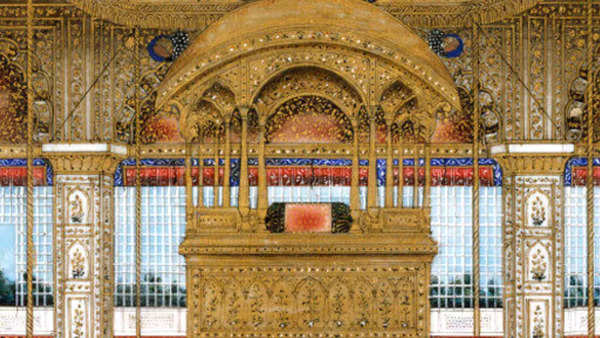The Peacock Throne, or ‘Mayurāsana’ as it was known, was not just a seat of authority but a marvel of design and embellishment. It was commissioned in the early 17th century and took seven painstaking years to complete. The throne was a masterpiece, adorned with an array of precious stones and metals, and its cost was a staggering figure, amounting to twice that of the Taj Mahal’s construction.

It’s most striking feature was the two bejewelled peacocks after which it was named. Source: Public Domain
Crafted by the skilled hands of the imperial goldsmiths, led by the master artisan Said Gilani, the throne was a evidence of the empire’s wealth and Shah Jahan’s love for the extravagant. The throne was ascended by silver steps and stood on golden feet set with jewels. Its most striking feature was the representations of two open peacocks’ tails, gilded and enameled, and inset with diamonds, rubies, and other stones, giving it the name by which it became known. The Peacock Throne was inaugurated in a triumphant ceremony on March 22, 1635, a date chosen by astrologers for its auspiciousness, coinciding with Eid al-Fitr and Nowruz, the Persian New Year.
The Peacock Throne was housed in the Diwan-i-Khas, the Hall of Private Audiences in the Red Fort of Delhi, where it dazzled courtiers and visiting dignitaries. Its sheer presence was a statement of the Mughal’s might and the emperor’s divine right to rule. The throne was encrusted with a staggering amount of jewels, including the famous Koh-i-Noor diamond, and other legendary gems like the Timur ruby and the Akbar Shah.
However, the throne’s fate was as dramatic as its inception. In 1739, it was captured as a war trophy by Nader Shah, the Persian invader, after his invasion of India. Before leaving India, Nader Shah had a divan made in the same style and brought both Peacock Thrones back to Iran, only to lose both in warfare with the Kurds, who apparently dismantled them and distributed the precious stones and metals. Its replacement disappeared during or soon after the Indian Rebellion of 1857.
The original Peacock Throne was reportedly one of the most splendorous thrones ever made, and its loss remains one of the great mysteries of history. Its legacy, however, endures in the form of reproductions and in the collective memory of a civilization that once epitomized the pinnacle of luxury and imperial power. The throne’s story is a reminder of the transient nature of material wealth and the enduring allure of beauty and artistry. The Peacock Throne may have been lost to time, but its legend continues to fascinate and inspire, a jewel in the crown of the Mughal Empire that once outshone even the Taj Mahal in monetary value and splendor.
Why Modi Linked ‘Wealth Redistribution’ To ‘Muslims First Right To Resources’ #ElectionsWithTOI

